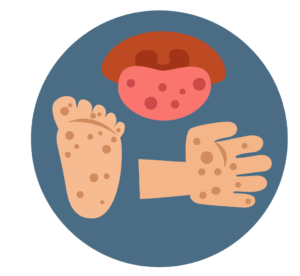Doctors’ Notes
BackHand-Foot-and-Mouth Disease
My child has a Disease?! Thankfully, it’s not as scary as it sounds.
Hand-Foot-and-Mouth Disease is a relatively common, contagious illness passed between children as easily as any other virus or cold. It’s typically caused by the enterovirus family, particularly coxsackie. You may hear your health care provider use the terms “coxsackie” and “Hand-Foot-and-Mouth” rather interchangeably.
 What Does it Look Like?
What Does it Look Like?
Your child will most likely present with painful, fluid-filled blisters — usually on the palms of the hands, the soles of the feet, and inside the mouth. (This explains how the illness got its oh-so-clever name.) However, the rash does not always pop up in those areas. You may notice that your child has a more widespread array of the blisters.
So is it Just a Blistery Rash?
No, it can present with other symptoms as well. The child typically does not feel well. In addition to dealing with painful blisters that make it hard to eat and drink, they may also suffer from flu-like symptoms, including fever and muscle aches. They may also want to sleep more, since they do not feel well.
What Do I Do For It?
Since it’s a virus, just as with the common cold, there’s no immediate cure for the illness. There are no medicines that will make it go away — just time. Hand, Foot, and Mouth disease typically lasts, like most other viruses, anywhere from several days to a week. At Kids Plus, will typically recommend treating the symptoms with common medications such as Tylenol or ibuprofen (to help with the pain). We may also recommend a mixture of Benadryl and Maalox in a 1:1 ratio, to be rinsed in the mouth and spit out if the child is old enough. If they’re not able to, your Provider will talk to you about how it can be mixed and dabbed onto the sores if the dose is appropriate.
What Do I Need to be Concerned About?
Typically the biggest concern is keeping your child hydrated. Because it hurts so much to swallow, kids may tend to avoid taking in any fluids. Colder liquids tend to be more comfortable for a child with Hand-Foot-and-Mouth. Popsicles can also be soothing and will help the child obtain a small amount of fluid in the meantime. If you have any concerns, or you think your child may be starting to get dehydrated, call the office or take your child to the emergency room immediately. Symptoms of dehydration to watch for carefully for are reduced urine output, dry mouth, and lethargy. (For more on dehydration, see Dr. Wolynn’s excellent Doctor’s Note.)
How Long is My Child Contagious?
Children are most contagious during the first week of the illness. They may, however, shed the virus from the nose and mouth for about 1-3 weeks and in their stool for weeks to months after the infection starts — so, as always, good hygiene is very important.
How Can I Prevent It?
There’s no ideal way to protect your child from Hand-Foot-and-Mouth. As with any virus, limiting exposure is key. If you know someone with the virus, wait until they’re better before seeing him or her. And, as always, good hand washing key to preventing the spread of germs.
Alyssa Papa, a certified Physician Assistant, joined Kids Plus in June 2012.